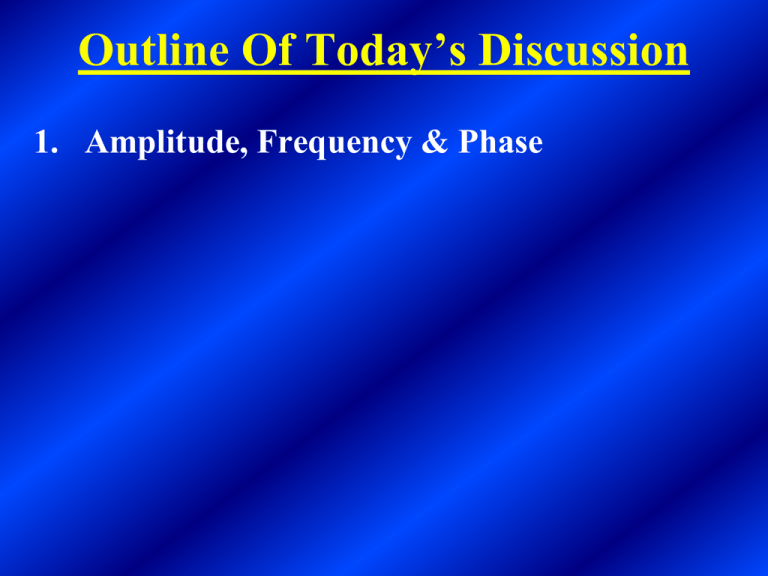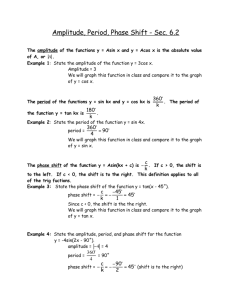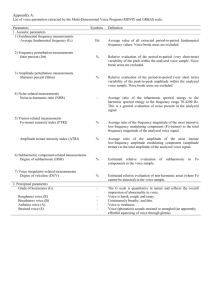PPT Lecture Notes
advertisement

Outline Of Today’s Discussion 1. Amplitude, Frequency & Phase Part 1 Amplitude, Frequency, & Phase Amplitude, Freq, Phase 1. Amplitude is the physical dimension of a wave that indicates the “peak to trough” displacement. 2. In acoustics, the greater the amplitude, the greater the intensity. 3. Here’s a graph of two waves differing in intensity (i.e., amplitude)…. Amplitude, Freq, Phase Amplitude Differences Perceptually, the greater the intensity the louder the sound. Amplitude, Freq, Phase 1. Now, let’s consider where intensity comes from. 2. When an object vibrates in a medium (say a tuning fork vibrating in air), it displaces air molecules nearby. 3. The displacements can be thought of as local changes in pressure, i.e., the number of air molecules per unit space. 4. Here’s a diagram showing such changes… Amplitude, Freq, Phase Filled circles = displaced air molecules: Open circles = nearby, stationary air molecules. Amplitude, Freq, Phase high pressure low pressure Filled circles = displaced air molecules: Open circles = nearby, stationary air molecules. Amplitude, Freq, Phase Compression (high pressure) Rarefaction (low pressure) Filled circles = displaced air molecules: Open circles = nearby, stationary air molecules. Amplitude, Freq, Phase 1. To reiterate… 2. Compressions are local regions of high pressure (many air molecules per unit space). 3. Rarefactions are local regions of low pressure (few air molecules per unit space). Amplitude, Freq, Phase 1. There is a mathematical relationship between pressure and intensity: 2. Intensity is proportional to pressure squared. 3. The human ear can respond to a 15 log unit range of intensities!!!! 4. Reminder: A log unit is also called an “order of magnitude”. In our class, a log unit will imply a ten-fold difference. So 3 log units is a 1,000-fold difference. Amplitude, Freq, Phase 1. Here’s a potential pop quiz question that extends over a few slides…: 2. A thumb-tack weighs 1 gram. 3. A Volkswagon Beetle weighs 1,350 kilograms, or 1,350,000 grams… Amplitude, Freq, Phase This car weighs 1,350,000 grams Amplitude, Freq, Phase 1. Assume we want to make a scale that can weigh objects over a range comparable to that of the human auditory system’s range of intensities -namely, 10 to the 15th power. 2. On the low end, we’ll have a thumb-tack that weighs 1 gram. 3. Potential Pop Quiz Question: How many Volkswagon Beetles will we need to represent the high end? Show Your Work! 4. This exercise will give you an intuitive feel for the range of intensities that you and I can hear. Amplitude, Freq, Phase 1. The decibel is the unit of measure corresponding to “displacement”. 2. Actually, the measure is the Bel (after Alexander Grahm Bel), but the Bel is so large that we chop it up into ten pieces…the decibel. 3. Sometimes decibels measure displacement in terms of pressure -Sound Pressure Level (SPL). 4. Other times, decibels measure displacement in terms of intensity -Intensity Level (IL). 5. In all cases, a decibel is the ratio of two quantities; either two pressures, or two intensities. Amplitude, Freq, Phase 1. The decibel formula for two pressures is this 2. dB = 20 * log( pressure X / standard pressure) 3. The standard pressure of 20 microPascals is the softest pressure that young adult humans can hear. 4. Potential Pop Quiz Question: If rustling leaves have a dB SPL of 20, then what must be the value inside the parenthesis? Amplitude, Freq, Phase 1. The decibel formula for two pressures is this 2. dB = 20 * log( pressure X / standard pressure) 3. The standard pressure of 20 microPascals is the softest pressure that young adult humans can hear. 4. Question: If rustling leaves have a dB SPL of 20, then what must be the value inside the parenthesis? 5. Answer: 10, since the log of 10 = 1, and 20*1= 20, which is the dB SPL of rustling leaves (left side of formula). 6. So, rustling leaves create a 10-fold increase in sound pressure. Amplitude, Freq, Phase 1. Importantly, the decibel is ALWAYS a relative measure. 2. In our class, we’ll talk about the the relation between two sound pressures…(dB SPL). 3. We could have, instead, chosen the relation of two intensities…(dB IL). 4. Now let’s consider frequency… Amplitude, Freq, Phase 1. As you know, frequency can be defined as the number of cycles per time, typically, cycles per second. 2. The unit of temporal frequency is Hertz. 3. Here are two stimuli that differ in temporal frequency… Amplitude, Freq, Phase Frequency Differences Amplitude, Freq, Phase Frequency Differences Which one will be heard as higher in pitch? Amplitude, Freq, Phase 1. So pitch is the perceptual correlate of frequency: High frequency high pitch, low frequency low pitch. 2. There is a reciprocal relation between frequency and wavelength. 3. 4. 5. Wavelength = speed of sound / frequency: Wavelength = (distance / time) / (cycles / time) Wavelength = distance per cycle 6. 7. 8. Frequency = speed of sound / wavelength: Frequency = (distance / time) / (distance / cycle) Frequency = cycles per time 9. In the following graph, note the “negative” slope of the line that shows wavelength as a function of frequency… Amplitude, Freq, Phase Frequency and wavelength are inversely related. Amplitude, Freq, Phase Let’s see a Fourier analysis on a complex acoustic sound. Amplitude, Freq, Phase Amplitude, Freq, Phase We can make complex Sounds from sine waves Amplitude, Freq, Phase 1. Finally, let’s consider Phase…the aspect of a wave that pertains to relative position (in time or space). 2. Phase is often expressed in angular units. 3. Here’s a diagram relating the phase of sine waves to angular shifts… Amplitude, Freq, Phase Phase Angle Amplitude, Freq, Phase 45 Degree Phase Difference 90 Degree Phase Difference 180 Degree Phase Difference Phase differences are critical for our ability to localize sounds.







